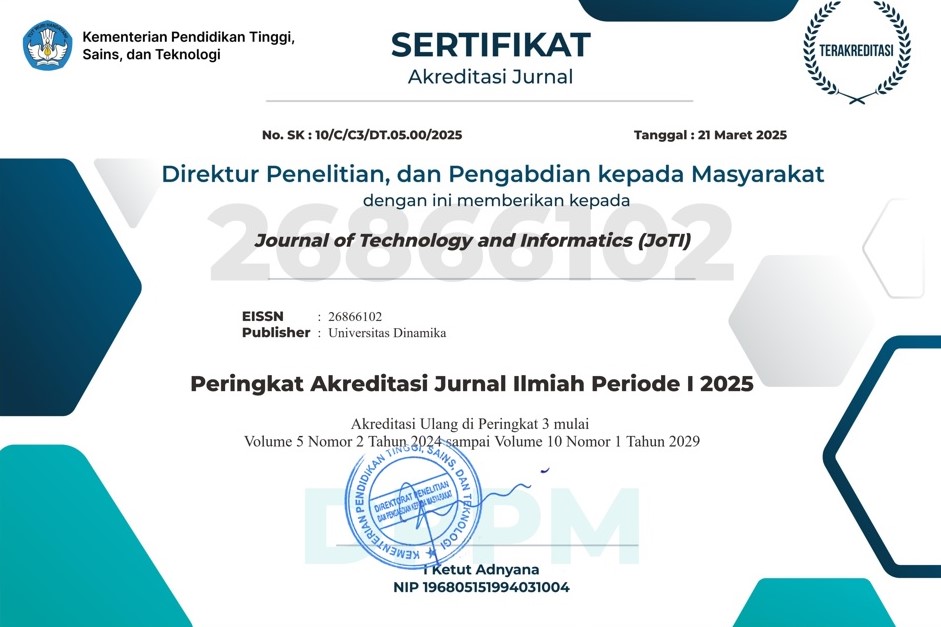A Hybrid Framework for Securing 5G-Enabled Healthcare Systems
DOI:
https://doi.org/10.37802/joti.v7i1.970Keywords:
AI-driven security, Blockchain, Healthcare data privacy, Zero-trust architecture, 5G networksAbstract
The rapid adoption of 5G technology in healthcare introduces significant challenges regarding data privacy and security. This paper proposes a hybrid framework integrating blockchain, zero-trust architecture (ZTA), and AI-driven threat detection to address these challenges. Blockchain ensures secure, tamper-proof data storage, while ZTA strengthens access control by continuously verifying users and devices. AI contributes by providing real-time threat detection and dynamic response capabilities, making the system more resilient to evolving cyber risks. A systematic literature review was conducted to analyze existing frameworks and identify gaps in 5G healthcare security. The findings reveal that while individual technologies such as blockchain and ZTA are well-established, their integration into a cohesive framework remains underexplored. The proposed hybrid solution effectively mitigates the risks associated with 5G networks by offering a multi-layered security approach. This research contributes to the field by proposing a scalable, adaptable security model suitable for 5G-enabled healthcare systems. Future research should focus on empirical validation, scalability testing, and exploring lightweight alternatives to blockchain and AI for resource-constrained environments. Additionally, investigating the integration of emerging technologies like quantum computing and 6G networks will further enhance the framework’s security capabilities. This study provides a foundation for developing secure, privacy-preserving systems for healthcare in the 5G era.
Downloads
References
D. H. Devi et al., “5G Technology in Healthcare and Wearable Devices: A Review,” Sensors, vol. 23, no. 5, p. 2519, Feb. 2023, doi: 10.3390/s23052519.
M. Javaid, A. Haleem, R. P. Singh, and R. Suman, “5G technology for healthcare: Features, serviceable pillars, and applications,” Intell. Pharm., vol. 1, no. 1, pp. 2–10, Jun. 2023, doi: 10.1016/j.ipha.2023.04.001.
A. I. Stoumpos, F. Kitsios, and M. A. Talias, “Digital Transformation in Healthcare: Technology Acceptance and Its Applications,” Int. J. Environ. Res. Public. Health, vol. 20, no. 4, p. 3407, Feb. 2023, doi: 10.3390/ijerph20043407.
A. Kumar et al., “Evaluation of 5G techniques affecting the deployment of smart hospital infrastructure: Understanding 5G, AI and IoT role in smart hospital,” Alex. Eng. J., vol. 83, pp. 335–354, Nov. 2023, doi: 10.1016/j.aej.2023.10.065.
S. M. A. A. Abir, M. Abuibaid, J. S. Huang, and Y. Hong, “Harnessing 5G Networks for Health Care: Challenges and Potential Applications,” in 2023 International Conference on Smart Applications, Communications and Networking (SmartNets), Istanbul, Turkiye: IEEE, Jul. 2023, pp. 1–6. doi: 10.1109/SmartNets58706.2023.10215757.
B. Chen et al., “A Security Awareness and Protection System for 5G Smart Healthcare Based on Zero-Trust Architecture,” IEEE Internet Things J., vol. 8, no. 13, pp. 10248–10263, Jul. 2021, doi: 10.1109/JIOT.2020.3041042.
Oluwabunmi Layode, Henry Nwapali Ndidi Naiho, Gbenga Sheriff Adeleke, Ezekiel Onyekachukwu Udeh, and Talabi Temitope Labake, “The role of cybersecurity in facilitating sustainable healthcare solutions: Overcoming challenges to protect sensitive data,” Int. Med. Sci. Res. J., vol. 4, no. 6, pp. 668–693, Jun. 2024, doi: 10.51594/imsrj.v4i6.1228.
C. Petersen, “Through Patients’ Eyes: Regulation, Technology, Privacy, and the Future,” Yearb. Med. Inform., vol. 27, no. 01, pp. 010–015, Aug. 2018, doi: 10.1055/s-0038-1641193.
Janet Ngesa, “Tackling security and privacy challenges in the realm of big data analytics,” World J. Adv. Res. Rev., vol. 21, no. 2, pp. 552–576, Feb. 2023, doi: 10.30574/wjarr.2024.21.2.0429.
S. Madanian, T. Chinbat, M. Subasinghage, D. Airehrour, F. Hassandoust, and S. Yongchareon, “Health IoT Threats: Survey of Risks and Vulnerabilities,” Future Internet, vol. 16, no. 11, p. 389, Oct. 2024, doi: 10.3390/fi16110389.
O. Kuznetsov, P. Sernani, L. Romeo, E. Frontoni, and A. Mancini, “On the Integration of Artificial Intelligence and Blockchain Technology: A Perspective About Security,” IEEE Access, vol. 12, pp. 3881–3897, 2024, doi: 10.1109/ACCESS.2023.3349019.
D. H. Devi et al., “5G Technology in Healthcare and Wearable Devices: A Review,” Sensors, vol. 23, no. 5, p. 2519, Feb. 2023, doi: 10.3390/s23052519.
Islam Ahmad Ibrahim Ahmad, Femi Osasona, Samuel Onimisi Dawodu, Ogugua Chimezie Obi, Anthony Chigozie Anyanwu, and Shedrack Onwusinkwue, “Emerging 5G technology: A review of its far-reaching implications for communication and security,” World J. Adv. Res. Rev., vol. 21, no. 1, pp. 2474–2486, Jan. 2024, doi: 10.30574/wjarr.2024.21.1.0346.
S. M. A. A. Abir, M. Abuibaid, J. S. Huang, and Y. Hong, “Harnessing 5G Networks for Health Care: Challenges and Potential Applications,” in 2023 International Conference on Smart Applications, Communications and Networking (SmartNets), Istanbul, Turkiye: IEEE, Jul. 2023, pp. 1–6. doi: 10.1109/SmartNets58706.2023.10215757.
H. Sadri et al., “Integration of Blockchain and Digital Twins in the Smart Built Environment Adopting Disruptive Technologies—A Systematic Review,” Sustainability, vol. 15, no. 4, p. 3713, Feb. 2023, doi: 10.3390/su15043713.
L. Theodorakopoulos, A. Theodoropoulou, and C. Halkiopoulos, “Enhancing Decentralized Decision-Making with Big Data and Blockchain Technology: A Comprehensive Review,” Appl. Sci., vol. 14, no. 16, p. 7007, Aug. 2024, doi: 10.3390/app14167007.
M. L. Jones, “Application of systematic review methods to qualitative research: practical issues,” J. Adv. Nurs., vol. 48, no. 3, pp. 271–278, Nov. 2004, doi: 10.1111/j.1365-2648.2004.03196.x.
L.-L. Ebidor and I. G. Ikhide, “Literature Review in Scientific Research: An Overview,” East Afr. J. Educ. Stud., vol. 7, no. 2, pp. 179–186, May 2024, doi: 10.37284/eajes.7.2.1909.
J. Gamboa-Cruzado, K. Echevarria-Otazo, D. Medina-Montes, S. A. Esquivel, D. O. Gago, and I. F. Muñoz, “Understanding how healthcare innovation is shaped by 5G technology: A comprehensive systematic review,” J. Infrastruct. Policy Dev., vol. 8, no. 16, p. 10171, Dec. 2024, doi: 10.24294/jipd10171.
A. Kumar et al., “Evaluation of 5G techniques affecting the deployment of smart hospital infrastructure: Understanding 5G, AI and IoT role in smart hospital,” Alex. Eng. J., vol. 83, pp. 335–354, Nov. 2023, doi: 10.1016/j.aej.2023.10.065.
L. A. Palinkas, S. M. Horwitz, C. A. Green, J. P. Wisdom, N. Duan, and K. Hoagwood, “Purposeful Sampling for Qualitative Data Collection and Analysis in Mixed Method Implementation Research,” Adm. Policy Ment. Health Ment. Health Serv. Res., vol. 42, no. 5, pp. 533–544, Sep. 2015, doi: 10.1007/s10488-013-0528-y.
S. R. Addula, K. Meduri, G. S. Nadella, and H. Gonaygunta, “AI and Blockchain in Finance: Opportunities and Challenges for the Banking Sector,” IJARCCE, vol. 13, no. 2, Feb. 2024, doi: 10.17148/IJARCCE.2024.13231.
Sunday Adeola Oladosu, Adebimpe Bolatito Ige, Christian Chukwuemeka Ike, Peter Adeyemo Adepoju, Olukunle Oladipupo Amoo, and Adeoye Idowu Afolabi, “Revolutionizing data center security: Conceptualizing a unified security framework for hybrid and multi-cloud data centers,” Open Access Res. J. Sci. Technol., vol. 5, no. 2, pp. 086–076, Aug. 2022, doi: 10.53022/oarjst.2022.5.2.0065.
P. Shojaei, E. Vlahu-Gjorgievska, and Y.-W. Chow, “Security and Privacy of Technologies in Health Information Systems: A Systematic Literature Review,” Computers, vol. 13, no. 2, p. 41, Jan. 2024, doi: 10.3390/computers13020041.
Adebimpe Bolatito Ige, Eseoghene Kupa, and Oluwatosin Ilori, “Aligning sustainable development goals with cybersecurity strategies: Ensuring a secure and sustainable future,” GSC Adv. Res. Rev., vol. 19, no. 3, pp. 344–360, Jun. 2024, doi: 10.30574/gscarr.2024.19.3.0236.
Z. Moezkarimi, F. Abdollahei, and A. Arabsorkhi, “Proposing a Framework for Evaluating the Blockchain Platform,” in 2019 5th International Conference on Web Research (ICWR), Tehran, Iran: IEEE, Apr. 2019, pp. 152–160. doi: 10.1109/ICWR.2019.8765280.
J. (Elaine) Chen, F. Bao, C. Li, and Y. Lin, “The Application and Ethics of Artificial Intelligence in Blockchain: A Bibliometric-Content Analysis,” J. Glob. Inf. Manag., vol. 31, no. 7, pp. 1–32, Jun. 2023, doi: 10.4018/JGIM.323656.
T. R. Xuan and S. Ness, “Integration of Blockchain and AI: Exploring Application in the Digital Business,” J. Eng. Res. Rep., vol. 25, no. 8, pp. 20–39, Aug. 2023, doi: 10.9734/jerr/2023/v25i8955.
S. Kumar, W. M. Lim, U. Sivarajah, and J. Kaur, “Artificial Intelligence and Blockchain Integration in Business: Trends from a Bibliometric-Content Analysis,” Inf. Syst. Front., Apr. 2022, doi: 10.1007/s10796-022-10279-0.
C. Elendu, T. C. Elendu, and I. D. Elendu, “5G-enabled smart hospitals: Innovations in patient care and facility management,” Medicine (Baltimore), vol. 103, no. 20, p. e38239, May 2024, doi: 10.1097/MD.0000000000038239.
H. Elahi, G. Wang, Y. Xu, A. Castiglione, Q. Yan, and M. N. Shehzad, “On the Characterization and Risk Assessment of AI-Powered Mobile Cloud Applications,” Comput. Stand. Interfaces, vol. 78, p. 103538, Oct. 2021, doi: 10.1016/j.csi.2021.103538.
M. AlJamal et al., “A Robust Machine Learning Model for Detecting XSS Attacks on IoT over 5G Networks,” Future Internet, vol. 16, no. 12, p. 482, Dec. 2024, doi: 10.3390/fi16120482.
T. Hoeschele, C. Dietzel, D. Kopp, F. H. P. Fitzek, and M. Reisslein, “Importance of Internet Exchange Point (IXP) infrastructure for 5G: Estimating the impact of 5G use cases,” Telecommun. Policy, vol. 45, no. 3, p. 102091, Apr. 2021, doi: 10.1016/j.telpol.2020.102091.
A. Afaq, N. Haider, M. Z. Baig, K. S. Khan, M. Imran, and I. Razzak, “Machine learning for 5G security: Architecture, recent advances, and challenges,” Ad Hoc Netw., vol. 123, p. 102667, Dec. 2021, doi: 10.1016/j.adhoc.2021.102667.
P. Thantharate and A. Thantharate, “ZeroTrustBlock: Enhancing Security, Privacy, and Interoperability of Sensitive Data through ZeroTrust Permissioned Blockchain,” Big Data Cogn. Comput., vol. 7, no. 4, p. 165, Oct. 2023, doi: 10.3390/bdcc7040165.
W. F. Shah, “Preserving Privacy and Security: A Comparative Study of Health Data Regulations - GDPR vs. HIPAA,” Int. J. Res. Appl. Sci. Eng. Technol., vol. 11, no. 8, pp. 2189–2199, Aug. 2023, doi: 10.22214/ijraset.2023.55551.
B. Patel, V. K. Yarlagadda, N. Dhameliya, K. Mullangi, and S. C. R. Vennapusa, “Advancements in 5G Technology: Enhancing Connectivity and Performance in Communication Engineering,” Eng. Int., vol. 10, no. 2, pp. 117–130, Oct. 2022, doi: 10.18034/ei.v10i2.715.
S. F. Ahmed et al., “Toward a Secure 5G-Enabled Internet of Things: A Survey on Requirements, Privacy, Security, Challenges, and Opportunities,” IEEE Access, vol. 12, pp. 13125–13145, 2024, doi: 10.1109/ACCESS.2024.3352508.
A. Ahad et al., “A Comprehensive review on 5G-based Smart Healthcare Network Security: Taxonomy, Issues, Solutions and Future research directions,” Array, vol. 18, p. 100290, Jul. 2023, doi: 10.1016/j.array.2023.100290.
Q. Tang, S. Kamarudin, S. N. A. Rahman, and X. Zhang, “Bridging Gaps in Online Learning: A Systematic Literature Review on the Digital Divide,” J. Educ. Learn., vol. 14, no. 1, p. 161, Sep. 2024, doi: 10.5539/jel.v14n1p161.
A. I. Weinberg and K. Cohen, “Zero trust implementation in the emerging technologies era: a survey,” Complex Eng. Syst., vol. 4, no. 3, Sep. 2024, doi: 10.20517/ces.2024.41.
A. K. Jameil and H. Al-Raweshidy, “A Digital Twin Framework for Real-Time Healthcare Monitoring: Leveraging AI and Secure Systems for Enhanced Patient Outcomes,” Dec. 16, 2024, In Review. doi: 10.21203/rs.3.rs-5107583/v1.
Rafiul Azim Jowarder and Sawgat Jahan, “Quantum computing in cyber security: Emerging threats, mitigation strategies, and future implications for data protection,” World J. Adv. Eng. Technol. Sci., vol. 13, no. 1, pp. 330–339, Sep. 2024, doi: 10.30574/wjaets.2024.13.1.0421.
A. Ali et al., “Blockchain-Powered Healthcare Systems: Enhancing Scalability and Security with Hybrid Deep Learning,” Sensors, vol. 23, no. 18, p. 7740, Sep. 2023, doi: 10.3390/s23187740.
A. Almalawi et al., “Enhancing security in smart healthcare systems: Using intelligent edge computing with a novel Salp Swarm Optimization and radial basis neural network algorithm,” Heliyon, vol. 10, no. 13, p. e33792, Jul. 2024, doi: 10.1016/j.heliyon.2024.e33792.
Downloads
Issue
Section
License
Copyright (c) 2025 Journal of Technology and Informatics (JoTI)

This work is licensed under a Creative Commons Attribution-ShareAlike 4.0 International License.


















